
October 7 to November 7, 2019
On November 7, 2019, the Surveying Deep-sea Corals, Sponges, and Fish Habitat expedition ended. This expedition was the latest in a series of multi-agency collaborations known as EXPRESS, short for EXpanding Pacific Research and Exploration of Submerged Systems.
Over the course of the expedition, the team successfully surveyed 15 different sites offshore Washington, Oregon, and California. Scientists completed 18 remotely operated vehicle (ROV) and 20 autonomous underwater vehicle (AUV) dives as well as 30 CTD casts. By conducting operations around the clock, scientists completed 50 quantitative ROV transects; took tens of thousands of AUV images of the seafloor; collected and preserved over 80 deep-sea coral, sponge, and rock samples; and collected and processed over 700 seawater, invertebrate, and sediment samples that will later undergo chemical, isotopic, and environmental DNA analyses (eDNA). Also, working with the Global Foundation for Ocean Exploration (GFOE) made it possible to stream ROV dives live online, allowing scientists to engage in education and outreach with the public in real time.
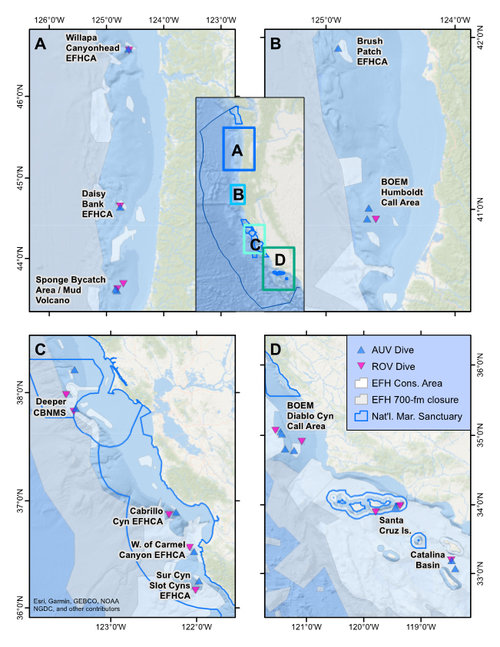
Locations of the 15 sites successfully surveyed during the Surveying Deep-sea Corals, Sponges, and Fish Habitat expedition. Image courtesy of the Surveying Deep-sea Corals, Sponges, and Fish Habitat. Download larger version (jpg, 400 KB).
During the expedition, the team:

Crew officers and scientists on the Reuben Lasker being training on the operation of the ROV and AUV. Image courtesy of the Surveying Deep-sea Corals, Sponges, and Fish Habitat. Download larger version (jpg, 478 KB).
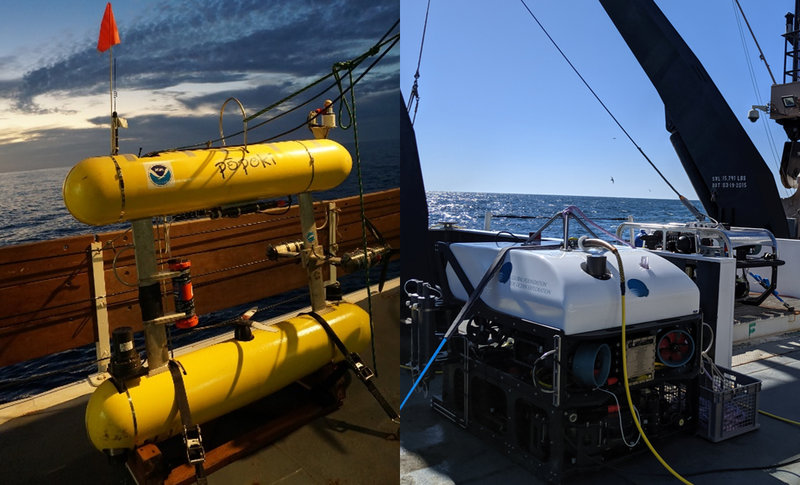
AUV Popoki (left) and ROVs Guru and Yogi (right) on the deck of the Reuben Lasker. Image courtesy of NOAA/UAF/Global Explorer Oceaneering. Download larger version (jpg, 614 KB).
During the expedition, the team used the NOAA National Marine Fisheries Service’s AUV, Popoki, and GFOE’s ROVs, Yogi and Guru, to collect quantitative imagery of the seafloor and associated fauna. Scientists will view these images back in the laboratory to identify and count the fauna and will then pass these data on for use in managing the fisheries and other resources on the West Coast.
Using ROV Yogi, scientists collected 34 corals and 40 sponges, along with numerous other animals. These samples will allow them to study the morphology and genetics of the sponges and corals, allowing scientists to put names to many of the corals and sponges seen in images collected during the expedition. Some of the collected animals have yet to be identified and could be new species.
During the expedition, the team tested the use of environmental DNA (eDNA) sequencing to describe deep-sea coral and sponge communities (and fish too!) in order to characterize the biodiversity of various habitats along the West Coast. All the organisms living in an area shed cells into the water column. eDNA sequencing is a technique that allows scientists to sequence cells filtered directly from water samples and analyze the genetic material in these cells in order to identify the species nearby.
During this expedition, scientists collected 57 samples for eDNA analyses. In the future, eDNA may provide scientists with a hands-off approach to assessing the distribution and abundance of animals in the sea.
With the expedition coming to a close, scientists are now working on the arduous and time-consuming process of identifying and counting the animals in the images taken by the ROVs and AUV. While they primarily do this manually now, in the future, they may have a little help.
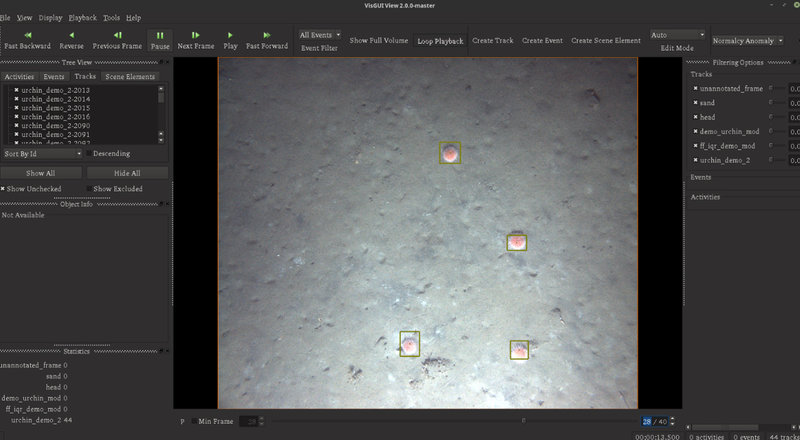
Screenshot from VIAME showing the pink urchins that were detected in this AUV image. Image courtesy of NOAA, USGS; taken from GFOE ROV Yogi. Download larger version (jpg, 517 KB).
For the first time on this EXPRESS expedition, scientists used machine learning to automate some of the image analyses and obtain rough counts of some target organisms while still at sea. To do this, they used an open-source software toolkit, Video and Image Analytics for a Marine Environment (VIAME) , which NOAA developed as part of a strategic initiative on automated image analysis.
While there is still a long way to go before full automation of image analysis, current computer vision tools are helping scientists maximize the use of the massive amounts of imagery collected and making the results available more quickly.

Nancy Prouty collects water samples from Nisken bottles. Image courtesy of the Surveying Deep-sea Corals, Sponges, and Fish Habitat. Download larger version (jpg, 547 KB).
Nancy Prouty and Amanda Demopoulos, from the U.S. Geological Survey (USGS), collected water samples from the 30 CTD casts and 30 Nisken bottle water collections by the ROV to characterize water column chemistry. Measurements of nutrients, pH, alkalinity, dissolved inorganic and organic carbon, and particulate organic material will provide a spatial gradient of the water column and near-bottom environmental properties that influence coral and sponge habitat.
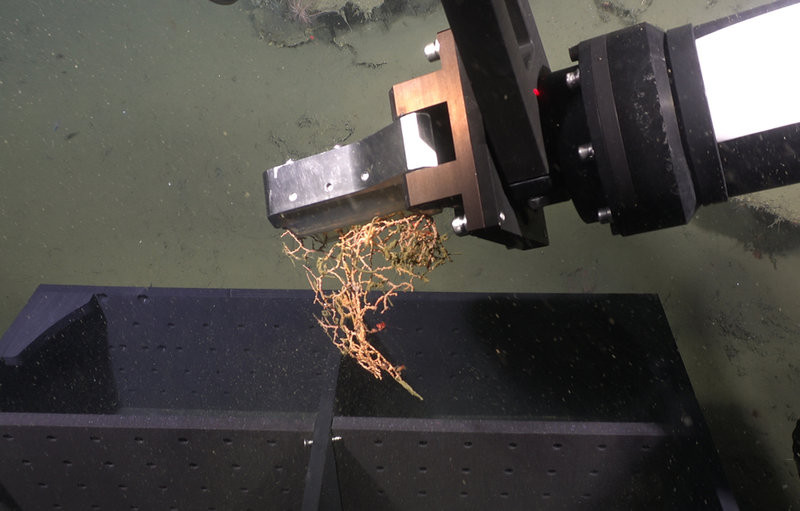
Coral sample held in the collecting arm of the ROV just before it is placed in the collecting box for transport to the ship. Image courtesy of the Surveying Deep-sea Corals, Sponges, and Fish Habitat. Download larger version (jpg, 423 KB).
The USGS scientists also are completing chemical analysis on the animals collected. They retained subsamples of the hundreds of animals, small and large, for isotopic analyses. From these analyses, they will determine where these animals fit in the benthic food web.
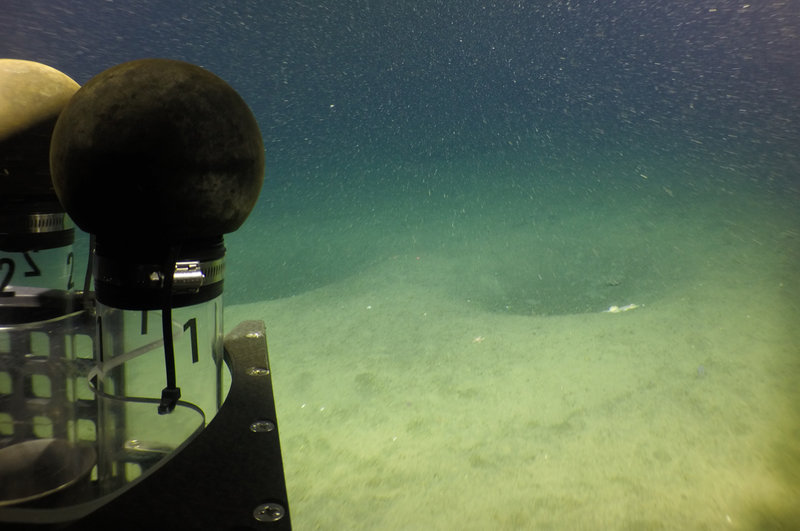
Pockmark-like features in the soft sediment along the start of an ROV Yogi transect along the accumulation resembling a fan or debris field to the southwest of the mud volcano cone. Image courtesy of NOAA, USGS; taken from GFOE ROV Yogi. Download larger version (jpg, 454 KB).
At a depth of nearly 500 meters (1,640 feet), on an otherwise relatively flat seafloor off the Oregon coast, a mud volcano rises 70 meters (230 feet) above the seafloor. The mound is a conical shape with a roughly circular base measuring 700 meters (2,300 feet) in diameter.
On October 12, 2019, ROV Yogi dove on an unexplored region of the mound, in an area resembling a fan or debris field to the southwest of the mound. The soft sediment was observed to provide habitat for sea stars, gastropods, brittle stars, sea pens, sea anemones, and a variety of fish, while the harder surface provided habitat for sponges and corals.
Mud volcanoes are common features in subduction zones, but detailed examinations of these features are rare. During the dive, scientists collected rock samples and some of the colorful bacterial mats observed, both of which they will evaluate later in the lab.
While real-time participation in remote events on land via video is now routine, the ability to connect to a live audience while at sea is still rare on most vessels. On this expedition, the testing of GFOE’s “flyaway” telepresence system provided the rare opportunity to connect live with the public and other scientists. The mostly self-contained system was loaded on the vessel at the beginning of the expedition and then removed at the end.
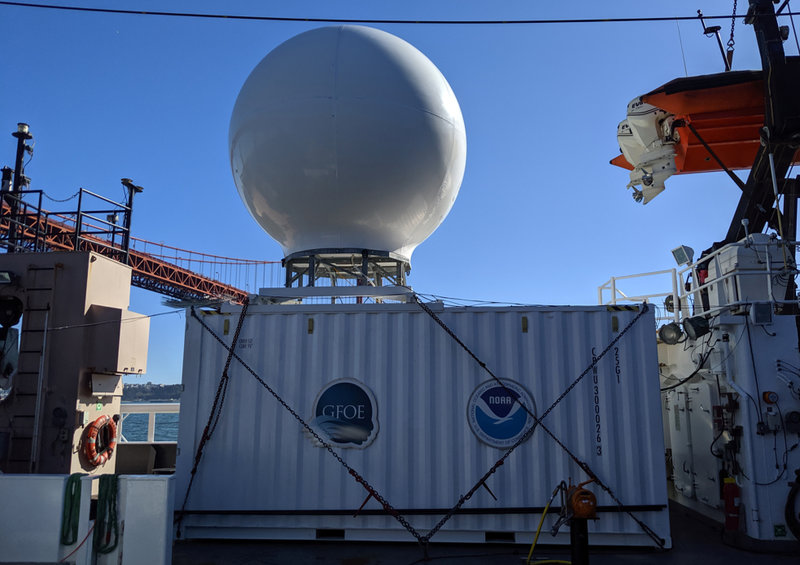
GFOE’s telepresence antenna and van on deck of NOAA Ship Reuben Lasker. Image courtesy of the Surveying Deep-sea Corals, Sponges, and Fish Habitat. Download larger version (jpg, 467 KB).
The video was live-streamed online from Yogi and Guru, allowing anyone on shore with an internet connection to hear live commentary from scientists, ask questions, and experience each dive as if they were on the ship. Also, the on-ship team hosted several remote video interactions with San Francisco’s Exploratorium and Pierpont Elementary School.
This expedition was part of the Expanding Pacific Research and Exploration of Submerged Systems, or EXPRESS, initiative – a multi-year, multi-agency project to survey and map undersea habitat throughout the California Current Large Marine Ecosystem.